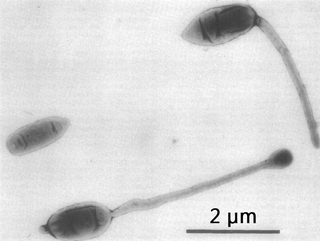Afifella is a genus in the phylum Pseudomonadota (Bacteria). Afifella are found in marine and estuarine settings, including microbial mats. They are anaerobes, with one cultured representative capable of photosynthesis.
Alishewanella is a genus in the phylum Pseudomonadota (bacteria).
Psychrobacter aestuarii is a Gram-negative, strictly aerobic, non-spore-forming, nonmotile bacterium of the genus Psychrobacter which was isolated from tidal flat sediment in the South Sea in Korea.
Aquamicrobium aestuarii is a gram-negative, catalase- and oxidase-positive strictly aerobic, motile bacteria with a flagellum from the genus of Aquamicrobium which was isolated from the Yellow Sea in South Korea.

Hyphomicrobium is a genus of Gram-negative, non-spore-forming, rod-shaped bacteria from the family of Hyphomicrobiaceae. It has a large polar or sub-polar filiform prostheca very similar to that of Caulobacter. In addition to having a nutritional function, the prostheca also plays a role in the initiation of DNA replication.
Hyphomicrobium chloromethanicum is an aerobic, methylotrophic bacteria from the genus of Hyphomicrobium which can utilize chloromethane as the only source of carbon.
Hyphomicrobium coagulans is a Gram-negative, non-spore-forming, methylotrophic bacteria from the genus of Hyphomicrobium.
Hyphomicrobium denitrificans is a bacterium from the genus of Hyphomicrobium which was isolated from the Netherlands.
Hyphomicrobium facile is a bacterium from the genus of Hyphomicrobium which was isolated from soil in New Hampshire in the United States.
Hyphomicrobium hollandicum is an aerobic bacteria from the genus of Hyphomicrobium which was isolated from soil in California in the US.
Hyphomicrobium methylovorum is a bacterium from the genus of Hyphomicrobium which was isolated from soil samples in Japan.
Hyphomicrobium nitrativorans is a bacterium from the genus of Hyphomicrobium which was isolated from biofilm at the Montreal Biodome in Canada.
Hyphomicrobium sulfonivorans is a bacterium from the genus of Hyphomicrobium which was isolated from garden soil in Warwickshire in England.
Hyphomicrobium vulgare is a bacterium from the genus of Hyphomicrobium.
Hyphomicrobium zavarzinii is a bacterium from the genus of Hyphomicrobium which was isolated from swampy soil in Moscow in Russia
Sphingomonas aestuarii is a Gram-negative and rod-shaped bacteria from the genus of Sphingomonas which has been isolated from tidal flat sediments in Yeosu in Korea.
Shewanella aestuarii is a Gram-negative, non-spore-forming, facultatively anaerobic, rod-shaped and motile bacterium with a polar flagellum from the genus Shewanella which has been isolated from tidal flat from the Suncheon bay on Korea.
Arenimonas aestuarii is a Gram-negative, aerobic and non-motile bacterium from the genus of Arenimonas which has been isolated from estuary sediments from Asan in Korea.
Leeuwenhoekiella aestuarii is a Gram-negative, aerobic and rod-shaped bacterium from the genus of Leeuwenhoekiella.
Algibacter aestuarii is a bacterium from the genus Algibacter.
